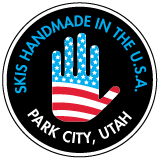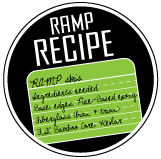RAMP
HANDMADE SKIS & SNOWBOARDS AT FACTORY DIRECT PRICES
At RAMP, we take pride in our technology. We have invented a number of new processes in ski manufacturing that are explained below.
 “Handmade in the USA”
“Handmade in the USA”
U.S. Labor and Manufacturing
Most companies that currently sell popular skis and snowboards in the U.S. have chosen to move their manufacturing plants from the U.S. to Asia. Their factory workers are making $200 per month and have never seen snow. At RAMP, we moved manufacturing from Taiwan back to the U.S. We believe that people who are passionate about skiing and riding naturally will work harder to make a superior product, as they love to ski/snowboard and care about their wares. We also recognize that business decisions come down to economics. If we took our factory floor, the same processes, materials, and moved them to a place with cheap labor and almost no environmental-cost concerns, the product costs less to make. However, RAMP has invented a new, cleaner manufacturing process that is significantly more efficient and flexible, thus allowing us to make superior product in the U.S. and compete with the big companies. We sell direct to skiers and riders so we can use more expensive materials, more expensive environmental practices, U.S. labor, and yet still provide great pricing and we can be profitable. We can’t stress enough what an advantage it is over being a typical outsourcing company; we have total control over manufacturing, innovation, environmental policies, and delivery.
 “Expanded Sweet Spot”
“Expanded Sweet Spot”
Vacuum molding
Since the ’60s skis have been molded using industrial presses that crush downward at 4 atmospheres of pressure forcing the layers in the ski against camber plates. The result is layers compressed into un-natural positions along the contact length of the ski creating very specific sweet spots, and very sensitive to small variations. RAMP is using a modern vacuum-molding process that mimics how virtually all modern aerospace products are molded today. In the vacuum bag, we work with 1 atmosphere of pressure, which is even in every direction. This process allows the layers and materials in the ski to seek their natural state versus being forced into an unnatural shape, which in turn creates a bigger sweet spot. The result is a high quality, better performing ski that is much easier to use.
 “Organic Metal"
“Organic Metal"
FSC Certified Bamboo wood cores
Virtually all skis and snowboards made today use poplar, a light durable wood that is relatively inexpensive. RAMP is using a core material that is 3 times as hard as poplar, but triple the cost. The result is a core that provides a dramatic improvement on the behavior of the ski. Normally wood cores provide an energetic feel due to their fibrous nature; from an engineering standpoint, the core is the center section of an I-Beam, the composite layers on top and bottom do most of the work. RAMP’s cores are so hard they actually make the ski feel like it has layers of metal but without the bending problems usually found with metal in freeskiing skis. Another great thing about bamboo is how renewable it is. Bamboo harvesting in Asia is notorious for its poor practices—no harvesting management and laminations wrought with formaldehyde. RAMP found a company called Plyboo in California that owns the factory, controls the harvesting, and the resins used. Our cores have Forestry Stewardship Certification, which is very rare with bamboo. We’ve noticed that some companies say they use bamboo cores, but when you look closely, it is usually bamboo strips mixed with poplar or simply a bamboo veneer. We don’t know of another company using full bamboo cores, especially at the level of quality and best practices being described here.
“Creative Freedom”
Total Sidecut Flexibility
RAMP has a patent-pending new technology that gives us the ability to change the sidecut shape of the ski without having to invest in a new mold. This is a serious breakthrough as it provides for maximum creativity. Normally a company tries to identify a trend in new shapes, buys/makes the molds, and then commits to the tooling. Trends may change or the new shape may not ski well. In any case, they are stuck with that mold for years as the tooling is very expensive, generally $8,000-$10,000 per model and size. At RAMP, we can now change the shape by changing the computer files. We can experiment with any shape and adapt after any test we do. It’s called rapid-prototyping and means ski design and shape are only limited by our imagination.
 “RAMP Recipe”
“RAMP Recipe”
Composites
RAMP is using more expensive, higher quality U.S.-made composites compared to skis made in Eastern Europe or Asia. When a ski flexes, the bottom layers are being stretched and the top layers compressed. We invested in a full layer of Kevlar in the bottom laminations of the ski, which has a dramatic effect on rebound, energy, durability and vibration absorption. Kevlar is used in bulletproof vests as it is so resistant to stretching-distortion and is incredibly strong. It is 7 times more expensive than fiberglass, but the effect it has on ski behavior is amazing. Imagine a smoother more solid ride. There is a very precise orientation of 45-degree triax fiberglass in the top and bottom outer layer to improve torsional characteristics. There also is a layer against the core on both sides of 90-degree fiberglass to provide strength and durability.
“Hand-Painted Art Going Fast”
Graphic Processes
RAMP has invented a new way to apply graphics onto a bamboo veneer (again FSC Certified), which we are told is impossible to do—to apply the graphics and then find a protective top sheet that adheres to the raw material. That was the challenge, but it only made us want to find a solution. It took many tests to determine the correct cocktail of colors, but we did. The result is a ski with graphics that appear hand-painted, rich and beautiful, authentic, and handmade. The ski looks like art on snow and is unique to the snowsports industry.
 “Super Sap”
“Super Sap”
Resin
Resins used in skis and snowboards are generally petro-chemical based. RAMP works with Entropy, a U.S. company that makes a resin called “Super Sap.” It is pine byproduct based. It has superior adhesion and strength characteristics and is much cleaner. No need to wear masks in the RAMP factory, we’re free to breathe here. Sure, it’s more expensive, but much safer for the environment and RAMP employees’ health.
“Royal Ride”
U.S. Bases
RAMP works with Crown Plastic that makes a superior 7500 Sintered Base here in the U.S. The Ohio-based company has a technology that allows it to introduce additives like carbon and wax directly into the material. The material combines the greatest impact strength of any thermoplastic, with a low coefficient of friction and tremendous abrasion resistance, which makes it an ideal material for the running surface of skis and snowboards.
Unisex and Women’s Product:
At RAMP, we enhance performance and usability for the size and strength of each rider by developing specific flexes and characteristics for each size ski and board.
The old model for creating women-specific skis and snowboards was tweaking men’s equipment with features like more forward ramp angles and binding positions. In reality these features are for skiers with less athletic ability and skill. At RAMP, we’re breaking the mold by creating skis and boards designed to fit your ability and size. Women who are athletic and strong want the same high-performance equipment men want. That being said, RAMP delivers unmatched women-specific models. A girl needs to be able to express herself!
Ski Sidecut:
After extensive testing RAMP is introducing a new sidecut concept called Razor Cut. This new shape drastically increases edge grip on skis. From the midpoint of the boot back the sidecut is straighter where you need cutting power and then becomes curved again for turn shape. This unique shape makes even our widest skis excellent on hard snow.
Camber for Skis:
At RAMP we have carefully studied the new trends in camber. There is a lot of exciting technology that makes it easier to ski in all conditions and increase versatility. The key is to apply the right technology to the specific product and rider. After extensive testing we found that the more early rise and reverse sidecut a product has in the tip, the better it performs in deep and soft snow. As a ski is designed for more and more carving on groomers and hard snow, early rise and reverse sidecut are reduced. At RAMP each model has a tip shape with the right amount of early rise and reverse sidecut specific to its use. If you’re riding a model that’s ridden switch like the Cork, the same is true for the tail. RAMP skis are as catch-free and effortless as skis can be for each specific use.
1) Pow Camber
• Maximum early rise and reverse sidecut in tip
• Strong tail with 20mm rise
• Best shape for deep powder and crud
• Used on Peacepipe
2) 50%-50% Camber
• Medium-plus early rise and reverse sidecut in tip
• Strong tail with 20mm rise
• Best shape for one ski quiver, half in pow, half on groomers
• Used on Woodchuck and Beaver
3) 65%-35% Camber
• Medium-minus early rise and reverse sidecut in tip
• Strong tail with 20mm rise
• Best shape for 65% on groomers but totally at home in powder and soft snow when you go there
• Used on Woodpecker and Chickadee
4) 80%-20% Camber
• Traditional camber for maximum performance at high speeds on hard snow
• Wide enough for fun on soft snow when you go there
• Used on Frenzy, Hysteria, Outrigger, Hula, Swarm and Honey
5) Freestyle Camber
• Medium-plus early rise and reverse sidecut in the tip and tail
• Most user-friendly twin ski when the snow changes, going from sun to shade, in the pipe or on different jumps
• Used on Cork, Cork Teen and Cork Kid
6) Pow Freestyle Camber
This camber is for the back-country powder hound who is doing tricks. The catch free tip has maximum early rise and reverse sidecut for effortless riding in deep. The sidecut is asymmetrical for maximum carving and surfing in any snow. The tail has early rise as well and a twin shape in the tail for landing switch, again catch free. The tail has less rise than the tip however making it more versatile than skis with symmetrical shapes. It can handle harder surfaces as a result as the tail is stronger.
Speed Ranges:
At RAMP we build skis and boards with flexes made specifically for the speed and athletic ability of each rider. Think of speed on a scale of 1-10 with 1 being an easy cruise and 10 being smoking fast. We’ve assigned a speed ranking to each ski and board to help you pick the one that’s just your speed.
Constructions:
At RAMP we’re committed to using the most high performance and durable construction available – a wood-core sandwich with vertical sidewalls. Our skis and boards have the energy and lively feel provided by a wood core, the edge grip provided by a substantial sidewall (ABS) molded above the edges and the durability to bring you through many tough runs. Of course we make modifications to the core profiles and layouts to specifically match the flex and characteristics of each skier and rider.
We’re also committed to producing our high-performance products with as little impact as possible on the environment. We source wood from renewable forests, and we use soy-based wax and citrus-based emulsions in our milling and finishing processes.
Camber for Snowboards:
Some shapes provide better performance for very specific uses and others provide greater versatility and easier use. Traditional camber provides the max pop and rebound off jumps. The most versatile shape we tested by far has early rise in the nose and tail with a flat zero camber in the mid body. This shape makes for a truly one-board quiver when matched with the right performance level construction. We make boards with traditional camber for riders who love to go big when they ride in the pipe and off jumps without sacrificing stability when ripping fast turns.
1) One Board Quiver Camber
• Has early rise in nose and tail with flat mid-body
• Used on Tumbleweed, Sagebrush, Prickly Pear, Gravy Train, Prairie Schooner and Tumbleweed Kid
2) Pop Camber
• Traditional shape for the most rebound you can get
• Used on the Lobstah, Mussel, Oyster and Tater Tot
Speed Ranges:
At RAMP we build skis and boards with flexes made specifically for the speed and athletic ability of each rider. Think of speed on a scale of 1-10 with 1 being an easy cruise and 10 being smoking fast. We’ve assigned a speed ranking to each ski and board to help you pick the one that’s just your speed.
Constructions:
At RAMP we’re committed to using the most high performance and durable construction available – a wood-core sandwich with vertical sidewalls. Our skis and boards have the energy and lively feel provided by a wood core, the edge grip provided by a substantial sidewall molded above the edges and the durability to bring you through many tough runs. Of course we make modifications to the core profiles and layouts to specifically match the flex and characteristics of each skier and rider.
We’re also committed to producing our high-performance products with as little impact as possible on the environment. We source wood from renewable forests, and we use soy-based wax and citrus-based emulsions in our milling and finishing processes.